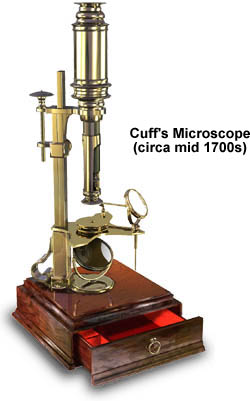John Cuff's Microscope
British microscope builder John Cuff introduced an innovative new microscope design in the mid 1700s that would be copied or "knocked-off" for many subsequent years. Cuff's microscopes were well constructed with a mechanical operation that was superior to other microscopes of the period.

The microscope base is made of oak, mahogany, or fruitwood and deeply stained or ebonized (stained black), with each base sporting a sliding wooden drawer usually lined in baize (red in this case). The main supporting limb is constructed of two pillars: one fixed and one sliding. The body tube is attached to the sliding pillar by means of a small arm, and the stage is attached directly below the body tube to the fixed pillar with a securing screw. The two pillars fit into a brass foot that is attached to the wooden base. Coarse focusing is achieved by unclamping the body tube and sliding the assembly up or down, while fine focus adjustments are performed by means of a small thumbscrew that acted by moving the sliding pillar in very small, but steady increments much like Marshall's great double design.
Cuff's microscope is equipped with a concave mirror at the base that acts to concentrate illuminating light rays onto a sample mounted on the stage. For opaque specimens, a large condensing lens is mounted above the stage to illuminate the surface for reflected light microscopy. The large hole in the center of the stage can hold a live box (used to restrain small animals and large insects) and, as shown in the illustration above, the stage can also accommodate a Bonanni-like spring stage. Objectives are placed in brass cells (termed buttons) and range in magnification from about 45x to 100x, but are only capable of resolving fine detail to a limit of 10 microns. Like other microscopes of the period, Cuff's objectives suffered from severe chromatic and spherical aberration. Later models employed Lieberkuhn reflectors to aid in specimen illumination.
BACK TO EIGHTEENTH CENTURY MICROSCOPES
